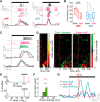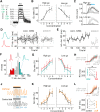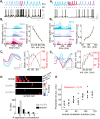Sniffing Fast: Paradoxical Effects on Odor Concentration Discrimination at the Levels of Olfactory Bulb Output and Behavior
- PMID: 30596145
- PMCID: PMC6306510
- DOI: 10.1523/ENEURO.0148-18.2018
Sniffing Fast: Paradoxical Effects on Odor Concentration Discrimination at the Levels of Olfactory Bulb Output and Behavior
Abstract
In awake mice, sniffing behavior is subject to complex contextual modulation. It has been hypothesized that variance in inhalation dynamics alters odor concentration profiles in the naris despite a constant environmental concentration. Using whole-cell recordings in the olfactory bulb of awake mice, we directly demonstrate that rapid sniffing mimics the effect of odor concentration increase at the level of both mitral and tufted cell (MTC) firing rate responses and temporal responses. Paradoxically, we find that mice are capable of discriminating fine concentration differences within short timescales despite highly variable sniffing behavior. One way that the olfactory system could differentiate between a change in sniffing and a change in concentration would be to receive information about the inhalation parameters in parallel with information about the odor. We find that the sniff-driven activity of MTCs without odor input is informative of the kind of inhalation that just occurred, allowing rapid detection of a change in inhalation. Thus, a possible reason for sniff modulation of the early olfactory system may be to directly inform downstream centers of nasal flow dynamics, so that an inference can be made about environmental concentration independent of sniff variance.
Keywords: Concentration; olfaction; olfactory bulb; oscillations; perception; sniffing.
Conflict of interest statement
The authors declare no conflicts of interest.
Figures





Similar articles
-
Inhalation Frequency Controls Reformatting of Mitral/Tufted Cell Odor Representations in the Olfactory Bulb.J Neurosci. 2018 Feb 28;38(9):2189-2206. doi: 10.1523/JNEUROSCI.0714-17.2018. Epub 2018 Jan 26. J Neurosci. 2018. PMID: 29374137 Free PMC article.
-
Similarity and Strength of Glomerular Odor Representations Define a Neural Metric of Sniff-Invariant Discrimination Time.Cell Rep. 2019 Sep 10;28(11):2966-2978.e5. doi: 10.1016/j.celrep.2019.08.015. Cell Rep. 2019. PMID: 31509755 Free PMC article.
-
Individual and synergistic effects of sniffing frequency and flow rate on olfactory bulb activity.J Neurophysiol. 2011 Dec;106(6):2813-24. doi: 10.1152/jn.00672.2011. Epub 2011 Sep 7. J Neurophysiol. 2011. PMID: 21900510
-
Coding odor identity and odor value in awake rodents.Prog Brain Res. 2014;208:205-22. doi: 10.1016/B978-0-444-63350-7.00008-5. Prog Brain Res. 2014. PMID: 24767484 Free PMC article. Review.
-
The sniff as a unit of olfactory processing.Chem Senses. 2006 Feb;31(2):167-79. doi: 10.1093/chemse/bjj016. Epub 2005 Dec 8. Chem Senses. 2006. PMID: 16339265 Review.
Cited by
-
Sniff Invariant Odor Coding.eNeuro. 2018 Dec 26;5(6):ENEURO.0149-18.2018. doi: 10.1523/ENEURO.0149-18.2018. eCollection 2018 Nov-Dec. eNeuro. 2018. PMID: 30627641 Free PMC article.
-
Respiration-Locking of Olfactory Receptor and Projection Neurons in the Mouse Olfactory Bulb and Its Modulation by Brain State.Front Cell Neurosci. 2020 Jul 16;14:220. doi: 10.3389/fncel.2020.00220. eCollection 2020. Front Cell Neurosci. 2020. PMID: 32765224 Free PMC article.
-
A Comparison between Mouse, In Silico, and Robot Odor Plume Navigation Reveals Advantages of Mouse Odor Tracking.eNeuro. 2020 Feb 4;7(1):ENEURO.0212-19.2019. doi: 10.1523/ENEURO.0212-19.2019. Print 2020 Jan/Feb. eNeuro. 2020. PMID: 31924732 Free PMC article.
-
Common principles for odour coding across vertebrates and invertebrates.Nat Rev Neurosci. 2024 Jul;25(7):453-472. doi: 10.1038/s41583-024-00822-0. Epub 2024 May 28. Nat Rev Neurosci. 2024. PMID: 38806946 Review.
-
How do mammals convert dynamic odor information into neural maps for landscape navigation?PLoS Biol. 2024 Nov 21;22(11):e3002908. doi: 10.1371/journal.pbio.3002908. eCollection 2024 Nov. PLoS Biol. 2024. PMID: 39571004 Free PMC article.
References
-
- Adrian ED (1950) The electrical activity of the mammalian olfactory bulb. Electroencephalogr Clin Neurophysiol 2:377–388. - PubMed
Publication types
MeSH terms
Grants and funding
LinkOut - more resources
Full Text Sources
Other Literature Sources
